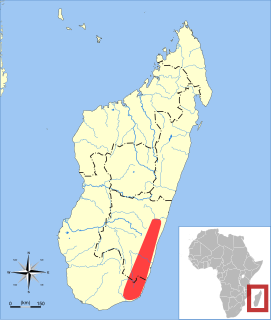
The little bent-wing bat or little long-fingered bat is a species of vesper bat in the family Miniopteridae. It is found in Australia, Indonesia, the Philippines, and Vanuatu.
The lesser long-fingered bat, also known as the black clinging bat or lesser bent-winged bat, is a species of vesper bat in the family Vespertilionidae. It is found in western Southern Africa, south East Africa, and parts of Central Africa. Its natural habitats are temperate forests, temperate shrubland, and caves and other subterranean habitats.
The Southeast Asian long-fingered bat is a species of vesper bat in the family [Miniopteridae]]. It is endemic to Japan and has been assessed as endangered by the IUCN.

Glen's long-fingered bat is a species of vesper bat in the family Miniopteridae found only in Madagascar.

The western bent-winged bat is a species of vesper bat in the family Miniopteridae. It can be found in the following countries: China, India, Indonesia, Laos, Malaysia, Myanmar, Papua New Guinea, Thailand, Timor-Leste, and Vietnam.

Major's long-fingered bat is a species of vesper bat in the family Miniopteridae. It is found only in Madagascar. It is similar to M. schreibersi of continental Africa, differing by having a shorter forearm, slightly longer digits and a narrow box-shaped skull. The pelage is often a greyish-brown colour, and the tragus is kidney-shaped and is a prominent feature. The species was named in honour of Swiss zoologist C. I. Forsyth Major.
The least long-fingered bat is a species of vesper bat in the family Miniopteridae. It can be found in the Republic of the Congo, the Democratic Republic of the Congo, Kenya, São Tomé and Príncipe, and Tanzania.

The small bent-winged bat is a species of vesper bat in the family Miniopteridae. A novel version of coronavirus has been identified in this species. It can be found in Bangladesh, Bhutan, India, Indonesia, Laos, Malaysia, Nepal, Philippines, Thailand and Vietnam.

The common bent-wing bat, also known as the Schreibers's long-fingered bat or Schreibers's bat, is a species of insectivorous bat. They appear to have dispersed from a subtropical origin and distributed throughout the southern Palearctic, Ethiopic, Oriental, and Australian regions. In Europe, it is present in the southern half on the continent from Iberia to the Caucasus, with the largest populations found in the warmer Mediterranean area. The common and scientific names honor Carl Franz Anton Ritter von Schreibers.

The great bent-winged bat is a species of vesper bat in the family Miniopteridae. It can be found in Indonesia, Papua New Guinea, Philippines, Solomon Islands, and Vanuatu.

Miniopterus, known as the bent-winged or long winged bats, is the sole genus of the family Miniopteridae. They are small flying insectivorous mammals, micro-bats of the order Chiroptera, with wings over twice the length of the body. The genus had been placed in its own subfamily among the vespertilionid bats, as Miniopterinae, but is now classified as its own family.

Peterson's long-fingered bat is a bat in the genus Miniopterus which occurs in southeast Madagascar. It was described by Steven M. Goodman et al. in 2008. While M. petersoni is similar to M. sororculus, the two species are not closely related to each other, and possess a number of differing external and cranial characteristics.

Griffith's long-fingered bat is a bat in the genus Miniopterus which occurs in southern Madagascar. M. griffithsi was previously a part of the largest family of bats, the Vespertilionidae, which consist of five subfamilies. The bat family Miniopteridae is widely distributed, ranging from the majority of sub-Saharan Africa to north Africa and Eurasia, as well as southern and southeastern Asia and Australia. Typical features of these bats include elongated third fingers, long narrow wings giving them a pointed shape when in flight, and a bent shape when folded, adding to the common name of bent-wing bats. M. griffithsi is similar to its sister species Miniopterus gleni, which lives north of the Onilahy River, while M. giffithsi lives south of it. Researchers first discovered that M. griffithsi was separate from M. gleni based on phylogeographic studies of the latter.

Miniopterus macrocneme is a bat in the genus Miniopterus. It is found primarily in the Loyalty Islands of New Caledonia, though it is also found in New Guinea. It has been considered a subspecies of Miniopterus pusillus in recent years. It lives in caves in large numbers, though it can also be found in forests.
Miniopterus newtoni is a species of bat that is endemic to São Tomé and Príncipe.

Miniopterus sororculus is a species of bat endemic to the highland forests of Madagascar.
Miniopterus maghrebensis, also known as the Maghrebian bent-wing bat, is a species of bat found in North Africa.
Miniopterus pallidus, the pale bent-wing bat, is a species of bat found in Middle-East. Until 2010, it was considered as a sub-species of M. schreibersii.












